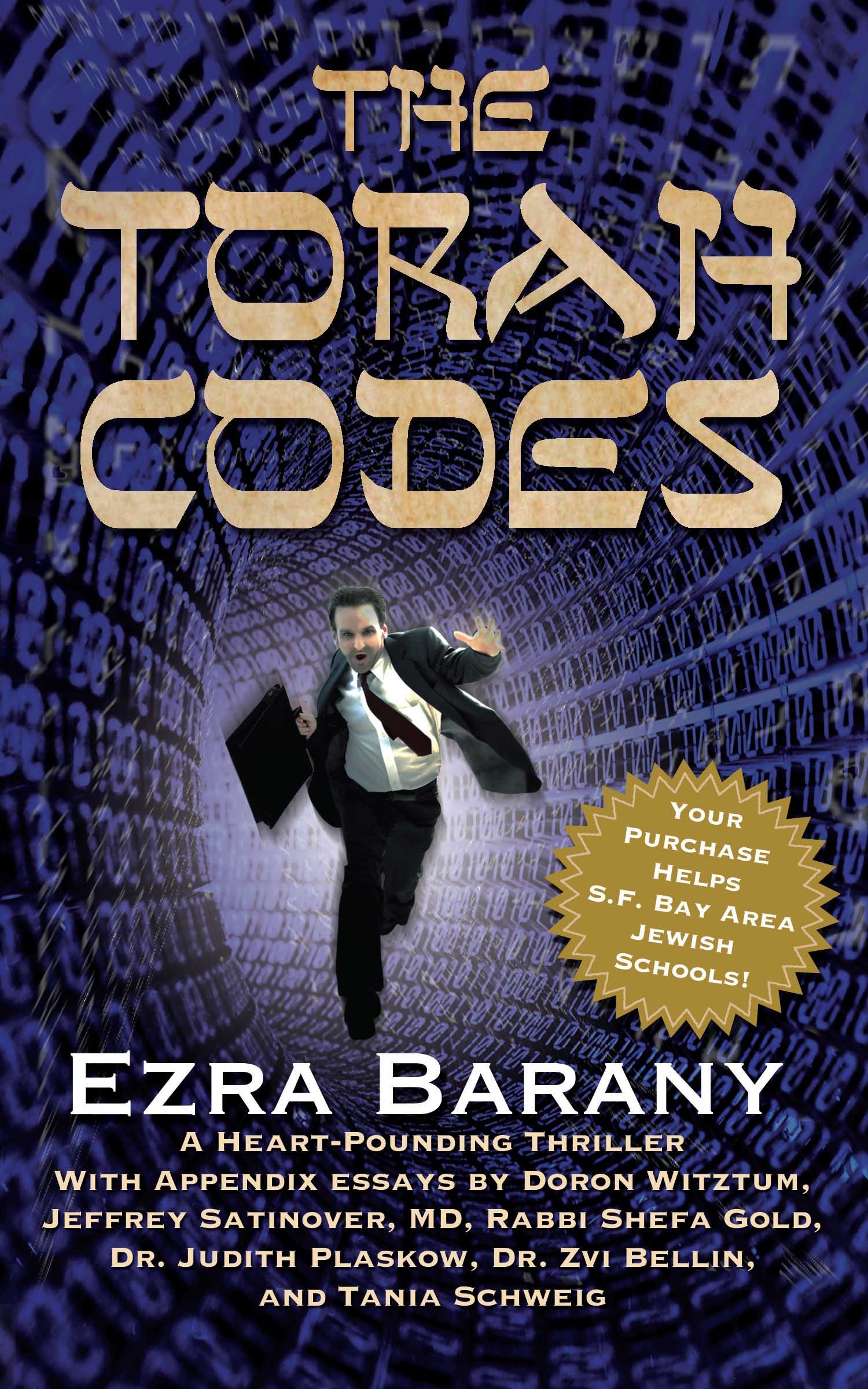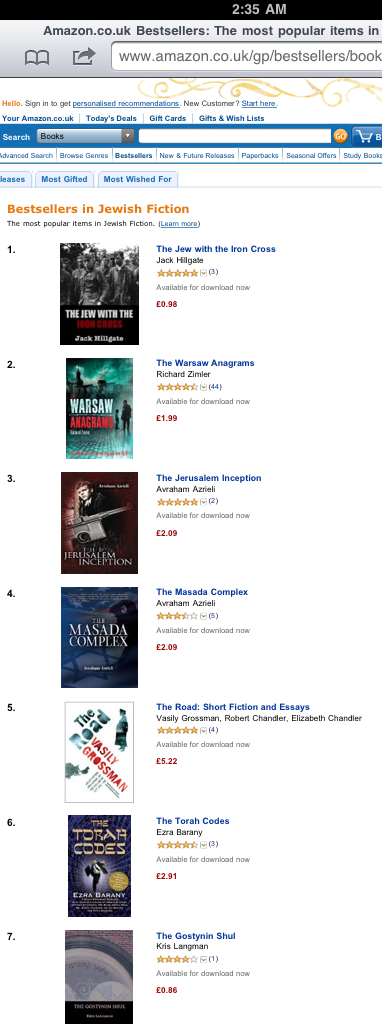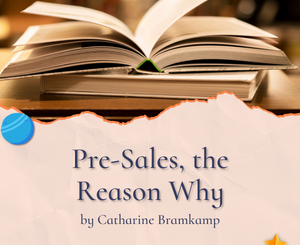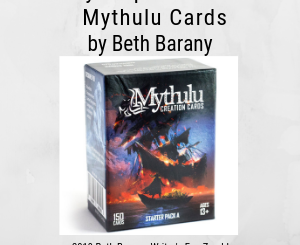7 Ways I Got on the Amazon Bestsellers Lists
How Amazon bestseller and award-winning author of the thriller, The Torah Codes, Ezra Barany, really got on the bestsellers’ lists.
***
When I self-published my thriller, The Torah Codes, my hope was that it would hit an Amazon bestseller list.
When my bride and book coach, Beth Barany, pointed out that my novel made two Amazon bestsellers lists in the U.K. (at the end of July 2011), I found it impossible to be true.
So unbelievable, in fact, that I found a way to discredit my achievement of bestseller status.
In September 2011, for my birthday, I ran an Amazon campaign. I busted my chops to get the word out to as many people as possible to buy my book that day. I also had a fun time running the campaign. But the results surprised me.
As many sales as I had made, I still didn’t make any of Amazon’s bestsellers lists. On December 22nd 2011, Beth showed me that The Torah Codes made it to a U.S. Amazon bestsellers list. By then, having struggled and failed to get it on a list before, I was more accepting of the value of my bestseller status.
But what did I do in December differently from my campaign that got me there?
The truth is, I’ve done a lot of different things and I couldn’t tell you exactly which one did the most to get me on the Amazon bestsellers list. But I do have some pretty good ideas of what worked and why.
So below is a list of what I did.
I encourage you to track and test the different methods as much as possible so that you know what works and what to spend more of your time focused on. At the very end of this post is a list of my marketing results for you to see the effectiveness of my suggestions.
Here are seven of the things I’ve done that have, in my mind, helped the most with getting me to Amazon’s bestsellers lists.
1. A Coveted Title: I specifically chose a title that was highly searched on search engines. Using Google’s adword keyword tool, I checked possible titles to see which had the most searches. I noticed that while “The Bible Codes” had many more monthly searches than “The Torah Codes,” there were a lot more websites talking about “Bible codes” compared to the few that specifically mention the phrase “Torah codes.” Since “Torah codes” had less competition and still had a healthy amount of monthly searches, I titled my book that way.
Now my blog TheTorahCodes.com is on the first page of search results. Not only that, but it wouldn’t surprise me if people do searches for “torah codes” in the Amazon search engine not knowing there’s a book called The Torah Codes. When they do, my book is the first one listed. So there, too, I get found easily for all who search for “the Torah codes.”
2. Obscure Categories: When I categorized my book for Amazon, I tried to place it in as deep a sub-category as possible. It is much easier to compete among all the books that are in the Fiction –> World Literature –> Jewish subcategory than the Fiction –> Thrillers subcategory.
3. Avoid “Out-Of-Stock” Status: Fortunately, ebooks are never out of stock, so there’s no risk in this area if your book is an ebook. For print books, having the book published by Amazon’s CreateSpace would ensure never having out-of-stock status. I, however, prefer Ingram’s Lightning Source for a print-on-demand company. For why, go here.
4. Amazon Campaign: It didn’t succeed with getting me to bestseller status, but by pulling together a team of people to spread the word about my campaign, I reached over two thousand people across the world. I also made the most sales ever of my book. For details on how I ran the Amazon campaign, go here.
5. Other People’s Lists (OPL): I sold over 50 books this December 2011, so far. I believe it was mostly due to promoting a teleseminar on “How to Finish Your Novel in 2012 Without Giving Up Your Life.” When I promoted the free teleseminar, I used Beth’s list of author contacts. (Over a thousand people!) Over one hundred people signed up to listen to the call. But more important than having many people on the call was being able to use Beth’s mailing list. Using other people’s lists (OPL) is the best way to spread the word about your book.
Clearly, though, it’s better to send information about your book to twenty readers who fit your market than to a hundred or even a thousand random people. So if I knew someone who had a mailing list of Jewish fiction readers, it would be in my best interest to provide that person and the readers on his or her list with something they would enjoy or appreciate. Jason Oman fittingly calls it “Loverage.”
6. Guest Blogging and Radio Shows: Getting seen on other people’s websites, newspapers, and radio shows is one of the best ways to get traffic to your Amazon book page. Ideally, the website or media host should reflect your readers’ market. I don’t recommend going on a talk show about car repairs expecting huge sales from mentioning your romance novel.
7. Paper.li: For more traffic to your Amazon page, here’s a trick that you can set up in just a few hours and then let it run on its own. Collect people’s articles onto one digital paper using this website, and let the contributors notice that you, the author of a great book, who has put it together. I haven’t seen spectacular results, yet, but since I don’t need to spend much time focusing on it, it’s good to have as a nearly automated marketing tool like this. Find out the step-by-step details on how to do this yourself in my previous Writer’s Fun Zone article, “How to Make More Book Sales,” here.
And now for something really cool…
BONUS SUGGESTION 1 – Reviews: Once your traffic is coming in to your Amazon page, be sure they have a reason to buy. Piles of positive reviews help convince a browser to become your reader. Start off by having friends and family plug in their reviews. Then find online readers of your genre to review your book on their website. Typically they’ll also place their reviews on Amazon. After fourteen reviews, I stopped going out of my way to find reviewers.
BONUS SUGGESTION 2 – SITB: Having the “Search Inside This Book” (SITB) — also called “Look Inside the Book” — feature available is important for those people who like to read a sample before they buy. Though most buyers probably purchase because of word-of-mouth, the browsing buyer gets a chance to see just how good the writing is. Learn how to set up the SITB feature here.
BONUS SUGGESTION 3 – Word of Mouth: Oh…yeah…and make sure your book is a good one. Just saying!
Above are what I believe to be the most leveraged methods of my marketing strategies, to date. I hope they help!
Let us know what worked for you!
 As promised, here are the stats of my marketing results:
As promised, here are the stats of my marketing results:
At the end of July 2011 in the U.K., my paperback version of The Torah Codes got into two bestsellers lists. The categories were in “Torah” and in “Jewish Fiction.”
Total number of U.K. sales in July: 1.In September 2011, my kindle version of The Torah Codes was released and I ran my Amazon campaign. In the U.K., the bestsellers lists are composed of a combination of print book sales and kindle sales. I made #9 in the “Jewish Fiction” category and #3 in the “Torah” category.
Total number of U.K. sales in September: 2 (1 kindle, 1 print).For my Amazon campaign, I promoted the release of my kindle version of The Torah Codes and did not make any bestsellers list in the U.S.
Total number of U.S. sales in September: 69.At the end of December, my kindle version made the bestsellers list in the “Jewish Literature” category. Amazon updates its lists hourly, so the position of The Torah Codes over the past few days has varied from about #36 to as high as #13.
Total number of U.S. sales in December so far: 51 (update: now 58!).
The obvious question is why did I make the bestseller list selling fewer kindle ebooks in December than in September?
Only one reason come to mind.
There were fewer overall sales of all the other books in that category in December.
But is that really feasible?
Do people buy fewer kindle books of Jewish fiction during Chanukah (in December) than during the Jewish New Year (in September)?
It seems to be so. It’s the only explanation. And with that sparse amount of Jewish fiction sales during December, my book was able to compete and reach bestseller status.
Leave a comment below on which method I mentioned you think works best and which method you’d like to try next!
To your success,
Ezra
 This post is by the award-winning bestselling author
This post is by the award-winning bestselling author
of The Torah Codes, Ezra Barany, and my husband.









[…] Ezra Barany talks about his promotion efforts on Amazon and the effect, or lack thereof, on the site’s bestseller lists: http://writersfunzone.com/blog/2011/12/28/7-ways-i-got-on-the-amazon-bestsellers-lists/ […]